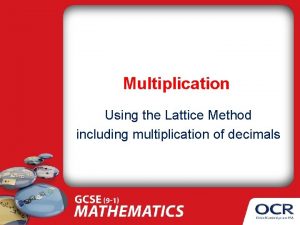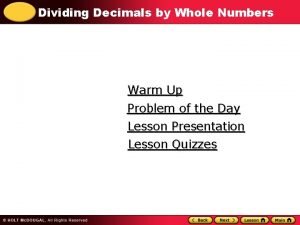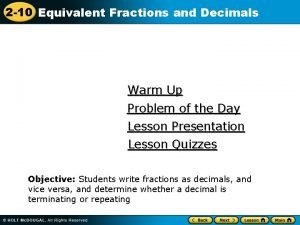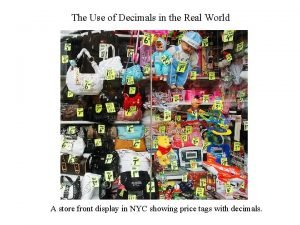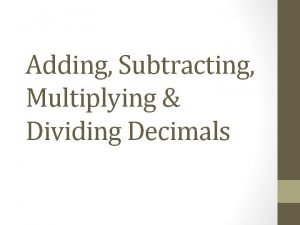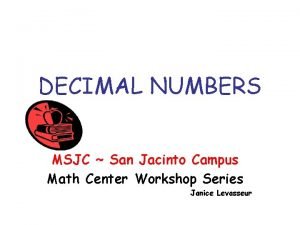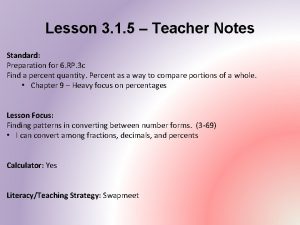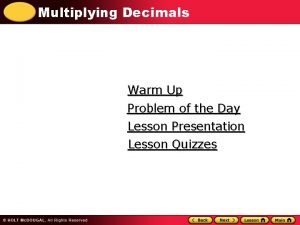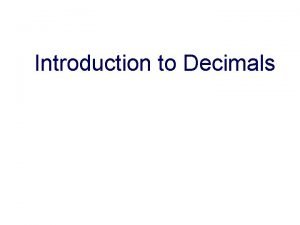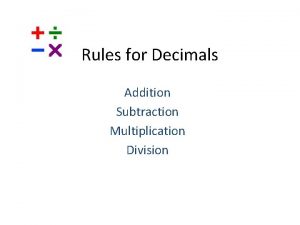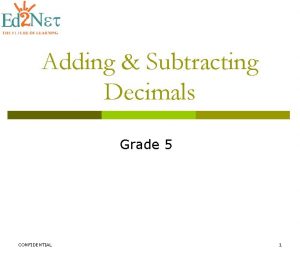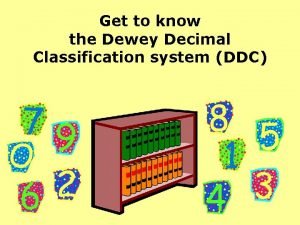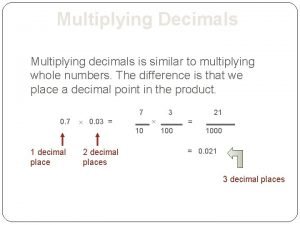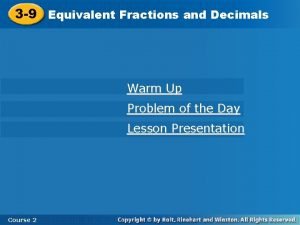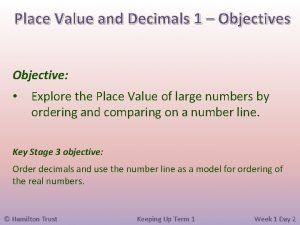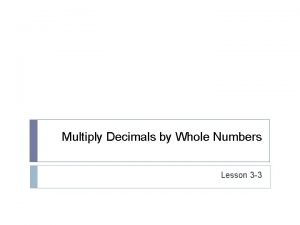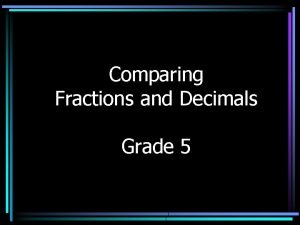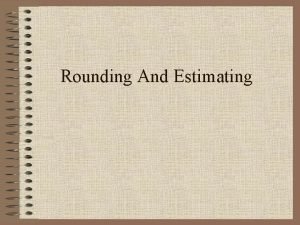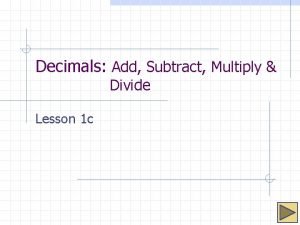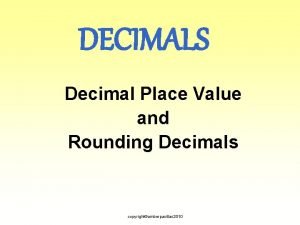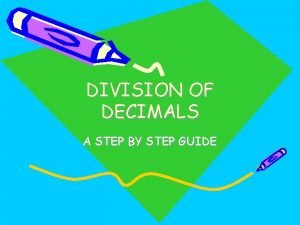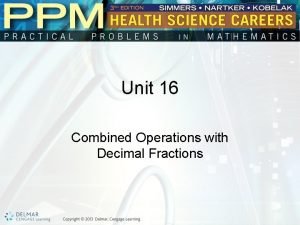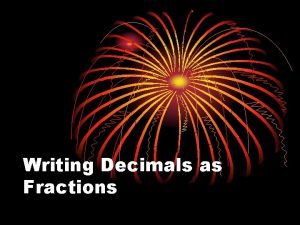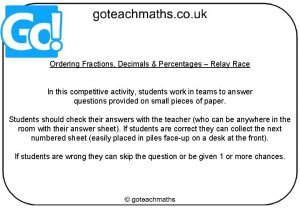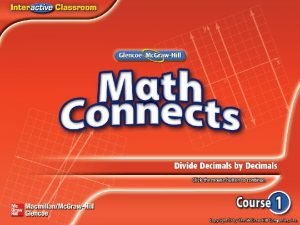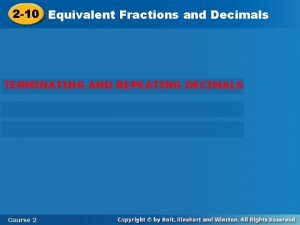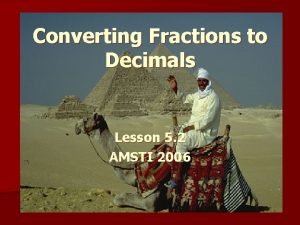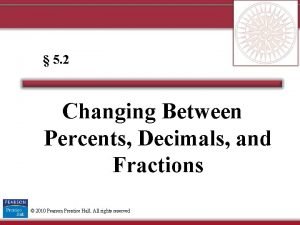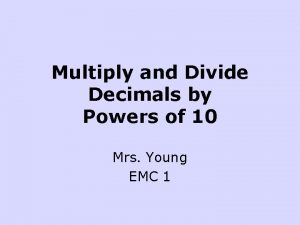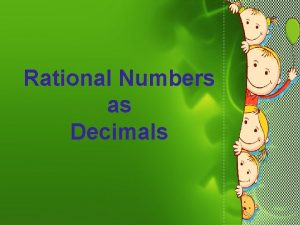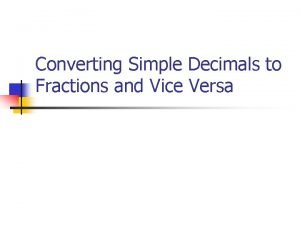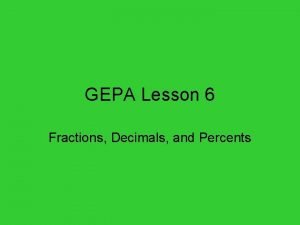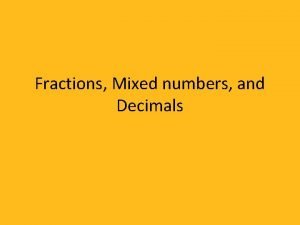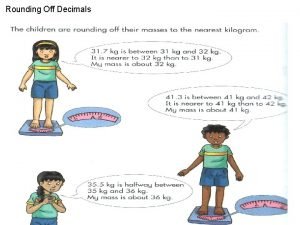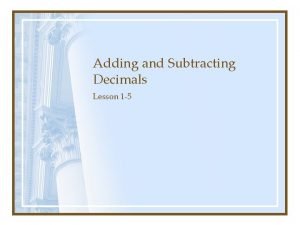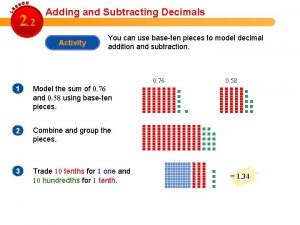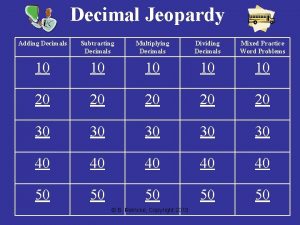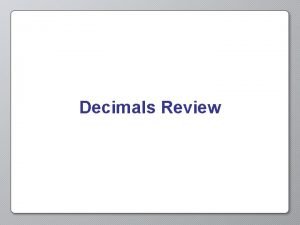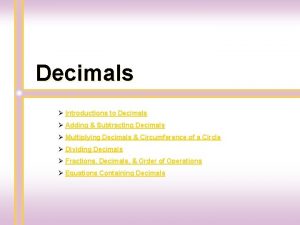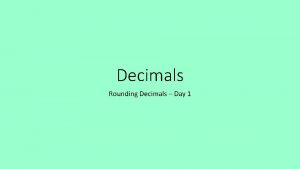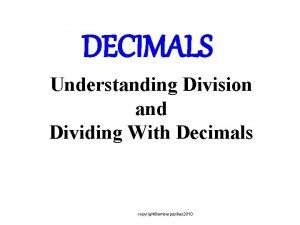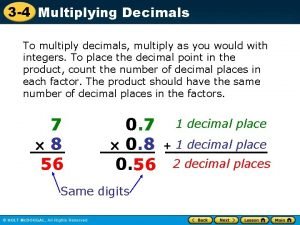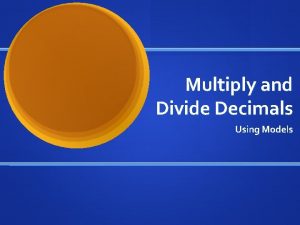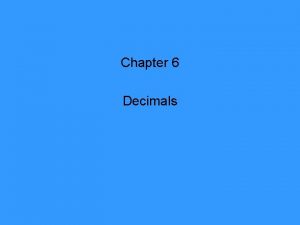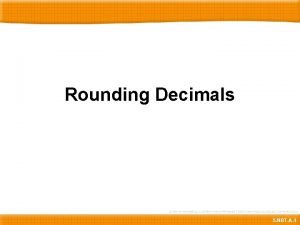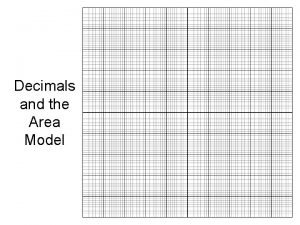Decimals Pages 60 95 Pages 62 63 Understanding




















































- Slides: 52

Decimals Pages 60 – 95

Pages 62 – 63 Understanding Decimals v Like a fraction, a decimal shows a part of a whole. Decimals divide a whole into 10 parts or 100 parts or 1, 000 parts and so on. If you have used money you’ve used decimals. v Decimals get their names from the number of places on the right side of the decimal point. The decimal point separates whole numbers from decimals. A place is the position for a digit. The decimal point itself does not take up a place.

_, _ _ _ millionths hundred thousandths ten thousandths hundredths thousandths ones tenths tens hundreds thousands ten thousands hundred thousands millions Pages 62 – 63 Place Value Names

Pages 62 – 63 Place Values Why do they have those names? 679. 328 600 70 9 3 10 2 100 8 1000

Pages 62 – 63 Mixed Decimals Mixed decimals are numbers with digits on both sides of the decimal point. $4. 95 is a mixed decimal. It means 4 whole dollars and 95/100 of a dollar. v As you move to the right in the decimal system, each place means that the whole has been divided into more parts, therefore, the values of the decimal places get smaller.

Pages 62 – 63 Example For each number, underline the digit that is in the place named 1. Tenths place 297. 18 2. Thousandths place 0. 04107 Circle the correct answer for the following question 3. Which of the following tells the value of the digit 9 in the number 2. 936? 9 tenths 9 hundredths 9 thousandths 9 ten-thousands

Pages 62 – 63 Group Work For each number, underline the digit that is in the place named 1. Hundredths place 0. 1389 2. Tenths place 0. 5864 Circle the correct answer for the following question 3. Which of the following tells the value of the digit 7 in the number 12. 047? 7 tenths 7 hundredths 7 thousandths 7 ten-thousands

Page 64 Reading Decimals v Remember that a decimal gets its name from the number of places at the right of the decimal point. v To read a decimal, count the places at the right of the decimal point. v With mixed decimals, watch for the word & which separates whole numbers from decimal fractions.

Page 64 Example v Write each decimal or mixed decimal in words 1. 0. 5 = Five tenths 2. 0. 07 = Seven hundredths 3. 10. 402 = Ten and four hundred two thousandths

Page 65 Writing Decimals v To write decimals from words, be sure that you have the correct number of decimal places. v Use zeros to hold places where necessary. v Remember, again, that the word & separates whole numbers from decimal fractions in mixed decimals. v Watch where zeros hold places.

Page 65 Example v Write the following as a decimal or a mixed decimal. 1. Five hundred-thousandths = 0. 00005 2. Forty-seven thousands 3. Forty-eight and nine tenths =48. 9 = 0. 047

Page 66 Getting Rid of Unnecessary Zero v Consider the number 020. 060 & decide whether each zero is necessary. • The zero left of the digit 2 is unnecessary • The zero right of the 2 is necessary because it keeps the 2 in the tens place. • The zero right of 6 is unnecessary • The number can be correctly written as 20. 06 v A decimal with no whole number is often written with a zero in the units place. The decimal. 8 & 0. 8 are both correct forms for eight tenths.

Page 66 Example For each number, choose the correctly rewritten number. 1. 5. 0060 a) 50. 6 b) 50. 06 c) 5. 006 d) 5. 06 2. 003. 1050 a) 3. 105 b) 30. 105 c) 3. 15 d) 30. 015 � 0700. 40 a) 70. 04 b) 70. 4 c) 700. 04 d) 700. 4 � 0040. 0920 a) 40. 92 b) 40. 092 c) 4. 092 d) 4. 92 v

Page 67 Changing Decimals to Fractions v To change a decimal to a fraction (or to change a mixed decimal to a mixed number), write the digits in the decimals as the numerator. v Write the denominator according to the number of decimal places. v Then reduce the fraction.

Page 67 Example v Write each number as a common fraction or a mixed number & reduce. 1. 0. 08 2. 3. 6 3. 0. 00324 4. 16. 00004

Page 67 Group Work v Write each number as a common fraction or a mixed number & reduce. 1. 0. 085 2. 7. 2 3. 2, 036. 8 4. 7. 22 5. 0. 375

Page 68 Changing Fractions to Decimals v Remember that a fraction can be understood as a division problem. v To change a fraction to a decimal, divide the denominator into the numerator. • To divide, add a decimal point & zeros to the numerator. • Usually two zeros are enough. v Then bring the point up in the answer.

Page 68 Example v Write 1. ¼ 2. 2/ 9 3. 3/ 5 each fraction as a decimal.

Page 68 Group Work v Write 1. 2/ 5 2. 6/ 25 3. 1/ 6 4. 3/ 8 5. 5/ 12 each fraction as a decimal.

Page 70 Comparing Decimals v When you look at a group of decimals, it is sometimes difficult to tell which decimal is the largest. To compare decimals, give each decimal the same number of places by adding zeros. This is the same as giving each decimal a common denominator. The zeros you add do not change the value of the decimals. v Don’t write the extra zeros in the final answer.

Page 70 Example v In each pair, tell which decimal is larger. 1. 0. 04 or 0. 008 2. 0. 328 or 0. 33 3. 0. 0057 or 0. 006

Page 70 Group Work v Arrange each list in order from the smaller to the largest. 1. 0. 03, 0. 33, 0. 033, 0. 303 2. 0. 106, 0. 16, 0. 061, 0. 6 3. 0. 4, 0. 405, 0. 45, 0. 045 4. 0. 0072, 0. 07, 0. 02

Pages 71 – 72 v To Rounding round a number, you must know the place value of each digit in the number. v To round a decimal: 1. Underline the digit in the place to which you want to round. 2. If the digit to the right of the underlined digit is 5 or more, add one to the underlined digit. 3. If the digit to the right of the underlined digit is 4 or less, do not change the underlined digit. 4. Drop the digits to the right of the underlined digit.

Pages 71 – 72 Example v Round each decimal to the nearest place value given. 1. Tenth 4. 29 2. Hundredth 0. 582 3. Whole number 5. 4068

Pages 71 – 72 Group Work v Round each decimal to the nearest place value given. 1. Tenth 516. 24 2. Hundredth 0. 0946 3. Whole number 1. 89

Page 73 Adding Decimals v To add decimals, line up the decimal points under each other. (Remember that whole numbers have a decimal point at its right. ) • This makes it so that you are adding the same place values to each other. v Then add

Page 73 Example v Add 1. 0. 8 + 0. 047 + 0. 36 2. 123 + 2. 6 + 9. 04 3. 9. 043 + 0. 27 + 15

Page 73 Group Work v Add 1. 0. 849 + 1. 6 + 73 2. 7. 563 + 0. 08 + 124. 9 3. 12. 3 + 0. 908 + 6 + 4. 25 4. 1. 6 + 23 + 12. 73 + 0. 485

Page 75 Subtracting Decimals v To subtract decimals line up the decimals with the points under each other just like in addition. • Remember to put a point to the right of a whole number. Put zeros at the right until each decimal has the same number of places. • You will need the zeros for borrowing.

Page 75 Example v Subtract 1. 4. 2 – 3. 76 2. 0. 804 – 0. 1673 3. 2 – 2. 68

Page 75 Group Work v Subtract 1. 0. 08 – 0. 0156 2. 1. 4 – 0. 978 3. 0. 6 – 0. 059

Pages 79 – 81 Multiplying Decimals v Multiply • as you would any whole numbers. To find the placement of the decimal in the product (the answer) ü Count the decimal places in each factor (the numbers you multiplied). ü Put the total number of decimal places in the product. (Sometimes you will need to put extra zeros in your answer. )

Pages 79 – 81 Example v Multiply 1. 2. 8 x 4. 3 2. (0. 81)(0. 69) 3. 45. 21(5. 6)

Pages 79 – 81 Group Work v Multiply 1. 5. 6 x 0. 82 2. (0. 94)(1. 8) 3. 34. 7(209)

Page 82 Multiplying Decimals by 10, 100, & 1, 000 v To multiply a decimal by 10, move the decimal point one place to the right. v To multiply a decimal by 100, move the decimal point two places to the right. v To multiply a decimal point by 1, 000, move the decimal point three places to the right. v You may have to add zeros to get enough places.

Page 82 Example v Multiply 1. 0. 8 x 10 2. 0. 721 x 10 3. 0. 06 x 1, 000

Page 82 Group Work v Multiply 1. $1. 25 x 10 2. $0. 60 x 100 3. $0. 03 x 1, 000

Page 86 Dividing Decimals by Whole Numbers v To divide a decimal by a whole number, line up the problem carefully. v Then divide as you would a whole number & bring the decimal point up into quotient (the answer) above its position in the problem. v Sometimes answers. you will need to put zeros in your

Page 86 Example v Divide 1. 33. 605 ÷ 65 2. 464. 31 ÷ 77 3. 1, 565. 2 ÷ 43

Page 86 Group Work v Divide 1. 52 ÷ 19 2. 216. 6 ÷ 38 3. 9. 516 ÷ 52

Pages 87 – 88 Dividing Decimals by Decimals v To divide a decimal by a decimal, first make a new problem. • Change the number you are dividing by (the divisor) into a whole number. • You can change the divisor into a whole number by moving the decimal point to the right end. • Then move the decimal point in the other number (the dividend) the same number of places. v Sometimes you will have to put extra zeros in the dividend.

Pages 87 – 88 Example v Divide 1. 0. 11648 ÷ 0. 64 2. 145. 44 ÷ 3. 6 3. 0. 3933 ÷ 0. 19

Pages 87 – 88 Group Work v Divide 1. 0. 522 ÷ 8. 7 2. 558. 6 ÷ 0. 06 3. 4. 48 ÷ 0. 008

Page 89 Dividing Whole Numbers by Decimals v To divide a whole number by a decimal, remember to put a decimal point at the right of the whole number. • Then move the points in both the divisor and the dividend. • You will have to put zeros in the dividend. v Not every division problem comes out even. When this happens, choose a place to round to (unless it is chosen for you in the directions). Then divide one place beyond the place you want to round to.

Page 89 Example v Divide 1. 3, 237 ÷ 0. 039 2. 33, 040 ÷ 5. 6 3. 37, 440 ÷ 0. 48

Page 89 Group Work v Divide 1. 1, 178 ÷ 0. 019 2. 21, 546 ÷ 51. 3 3. 2, 135 ÷ 4. 27

Page 90 Dividing Decimals by 10, 100, & 1, 000 v To divide a decimal by 10, move the decimal point one place to the left v To divide a decimal by 100, move the decimal point two place to the left v To divide a decimal by 1, 000, move the decimal point three place to the left v You may have to add zeros to get enough places.

Page 90 Example v Divide 1. $20 ÷ 1, 000 2. $540 ÷ 1, 000 3. $650 ÷ 100

Page 90 Group Work v Divide 1. $2. 19 ÷ 10 2. 15. 8 ÷ 1, 000 3. 6, 954 ÷ 1, 000

Page 91 Dividing to Fixed Place Accuracy v Adding zeros to a division of decimals problem does not always result in a problem that divides evenly. v To get a division answer that is accurate to the nearest tenth, divide to the hundredths place & round the answer to the nearest tenth. v This is called dividing to fixed place accuracy.

Page 91 Example v Divide. Find the answer to the nearest tenth. 1. 6. 3 ÷ 0. 8 2. 72. 6 ÷ 50. 3 3. 12. 3 ÷ 7

Page 91 Group Work v Divide 1. 204 ÷ 9. 2 2. 10. 3 ÷ 0. 35 3. 49. 5 ÷ 36
 Printed pages vs web pages
Printed pages vs web pages Comparing decimals year 5
Comparing decimals year 5 Multiplying decimals grid method
Multiplying decimals grid method 1/9 as a decimal
1/9 as a decimal Lattice method in multiplication
Lattice method in multiplication How to divide a decimal by whole number
How to divide a decimal by whole number Equivalent fractions of 2/10
Equivalent fractions of 2/10 Decimals in real life
Decimals in real life Prometheus round 2 decimals
Prometheus round 2 decimals Add subtract multiply and divide decimals worksheet
Add subtract multiply and divide decimals worksheet Nrich maze 100 answers
Nrich maze 100 answers Gcse recurring decimals questions
Gcse recurring decimals questions How to move decimal places
How to move decimal places Lesson 3 percents and decimals
Lesson 3 percents and decimals Multiplying decimals jeopardy
Multiplying decimals jeopardy Introduction to decimals
Introduction to decimals Multiplication division rules
Multiplication division rules Adding and subtracting decimals jeopardy
Adding and subtracting decimals jeopardy Dewey decimals
Dewey decimals Multiplication of decimals
Multiplication of decimals Christmas decimals and fractions
Christmas decimals and fractions Writing fractions as decimals
Writing fractions as decimals Objectives of decimals
Objectives of decimals Lesson 3 multiply decimals by whole numbers
Lesson 3 multiply decimals by whole numbers Fractions decimals and percents calculator
Fractions decimals and percents calculator Channel 5 2005
Channel 5 2005 Clustering estimation with decimals
Clustering estimation with decimals Add subtract multiply divide decimals
Add subtract multiply divide decimals Tenths plac
Tenths plac How to divide decimals step by step
How to divide decimals step by step Combined operations on decimals
Combined operations on decimals 99/100 as a fraction in simplest form
99/100 as a fraction in simplest form Ordering fractions decimals and percentages
Ordering fractions decimals and percentages How to find a fraction of a number
How to find a fraction of a number Dividing decimals examples
Dividing decimals examples Decimal places value
Decimal places value Writing fractions as decimals
Writing fractions as decimals How to multiply using lattice method
How to multiply using lattice method Converting fractions to decimals lesson
Converting fractions to decimals lesson Converting between percents decimals and fractions
Converting between percents decimals and fractions Pemdas with decimals
Pemdas with decimals Multiplying and dividing decimals by powers of 10
Multiplying and dividing decimals by powers of 10 Terminating numbers
Terminating numbers Changing decimals to fractions and vice versa
Changing decimals to fractions and vice versa Two sevenths as a percentage
Two sevenths as a percentage Rounding decimals jeopardy
Rounding decimals jeopardy Convert fractions and mixed numbers to decimals
Convert fractions and mixed numbers to decimals 515 rounded to the nearest ten
515 rounded to the nearest ten Adding and subtracting decimals jeopardy
Adding and subtracting decimals jeopardy Changing fractions to decimals
Changing fractions to decimals How to multiply fractions with decimals
How to multiply fractions with decimals Write a poem about how to round off numbers
Write a poem about how to round off numbers Adding decimals activity
Adding decimals activity




